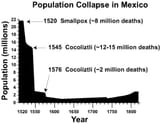Search Results
7/25/2025, 5:43:54 AM
>>17870035
>The Cocoliztli Epidemic or the Great Pestilence was an outbreak of a mysterious illness characterized by high fevers and bleeding which caused 5–15 million deaths in New Spain during the 16th century. The Aztec people called it cocoliztli, Nahuatl for pestilence. It ravaged the Mexican highlands in epidemic proportions, resulting in the demographic collapse of some Indigenous populations
>Based on the death toll, this outbreak is often referred to as the worst epidemic in the history of Mexico. Subsequent outbreaks continued to baffle both Spanish and native doctors, with little consensus among modern researchers on the pathogenesis. However, recent bacterial genomic studies have suggested that Salmonella, specifically a serotype of Salmonella enterica known as Paratyphi C, was at least partially responsible for this initial outbreak. Others believe cocoliztli was caused by an indigenous viral hemorrhagic fever, perhaps exacerbated by the worst droughts to affect that region in 500 years and poor living conditions for Indigenous peoples of Mexico following the Spanish conquest (c. 1519)
>The reducciones brought people and animals in much closer contact with one another. Animals imported from the Old World were potential disease vectors for illnesses. The Aztecs and other Indigenous groups affected by the outbreak were disadvantaged due to their lack of exposure to zoonotic diseases. Given that many Old World pathogens may have caused the cocoliztli outbreak, it is significant that all but two of the most common species of domestic mammalian livestock (llamas and alpacas being the exceptions) come from the Old World.
>The Cocoliztli Epidemic or the Great Pestilence was an outbreak of a mysterious illness characterized by high fevers and bleeding which caused 5–15 million deaths in New Spain during the 16th century. The Aztec people called it cocoliztli, Nahuatl for pestilence. It ravaged the Mexican highlands in epidemic proportions, resulting in the demographic collapse of some Indigenous populations
>Based on the death toll, this outbreak is often referred to as the worst epidemic in the history of Mexico. Subsequent outbreaks continued to baffle both Spanish and native doctors, with little consensus among modern researchers on the pathogenesis. However, recent bacterial genomic studies have suggested that Salmonella, specifically a serotype of Salmonella enterica known as Paratyphi C, was at least partially responsible for this initial outbreak. Others believe cocoliztli was caused by an indigenous viral hemorrhagic fever, perhaps exacerbated by the worst droughts to affect that region in 500 years and poor living conditions for Indigenous peoples of Mexico following the Spanish conquest (c. 1519)
>The reducciones brought people and animals in much closer contact with one another. Animals imported from the Old World were potential disease vectors for illnesses. The Aztecs and other Indigenous groups affected by the outbreak were disadvantaged due to their lack of exposure to zoonotic diseases. Given that many Old World pathogens may have caused the cocoliztli outbreak, it is significant that all but two of the most common species of domestic mammalian livestock (llamas and alpacas being the exceptions) come from the Old World.
Page 1
